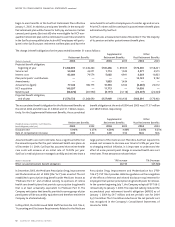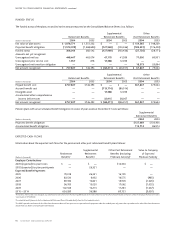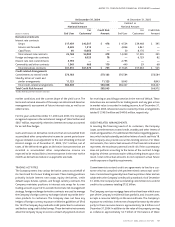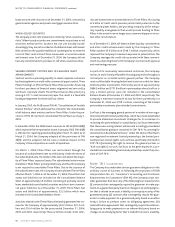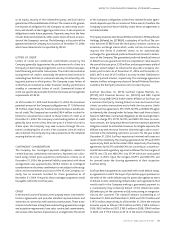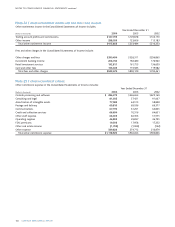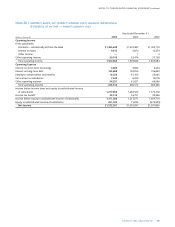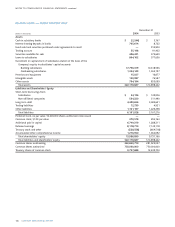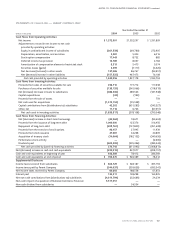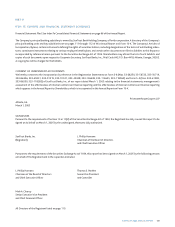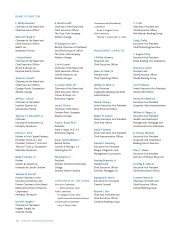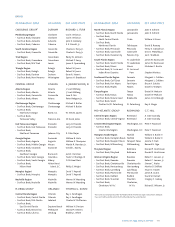SunTrust 2004 Annual Report Download - page 103
Download and view the complete annual report
Please find page 103 of the 2004 SunTrust annual report below. You can navigate through the pages in the report by either clicking on the pages listed below, or by using the keyword search tool below to find specific information within the annual report.
NOTES TO CONSOLIDATED FINANCIAL STATEMENTS continued
SUNTRUST 2004 ANNUAL REPORT 101
• Mortgage servicing rights are valued through a review of valua-
tion assumptions that are supported by market and economic
data collected from various sources.
• Deposit liabilities with no defined maturity such as demand
deposits, NOW/money market accounts, and savings accounts
have a fair value equal to the amount payable on demand at the
reporting date, i.e., their carrying amounts. Fair values for certifi-
cates of deposit are estimated using a discounted cash flow cal-
culation that applies current interest rates to a schedule of
aggregated expected maturities. The intangible value of long-
term relationships with depositors is not taken into account in
estimating fair values.
• Fair values for long-term debt are based on quoted market prices
for similar instruments or estimated using discounted cash flow
analysis and the Company’s current incremental borrowing rates
for similar types of instruments.
Note 21 / CONTINGENCIES
On January 11, 2005, the Securities and Exchange Commission
issued a formal order of investigation and the SEC Staff issued sub-
poenas seeking documents related to the Company’s allowance for
loan losses and related matters.The Company is cooperating, and
intends to cooperate with the SEC regarding this matter.In addition,
the Company and its subsidiaries are parties to numerous claims
and lawsuits arising in the course of their normal business activities,
some of which involve claims for substantial amounts. The
Company’s experience has shown that the damages alleged by
plaintiffs or claimants are grossly overstated, often unsubstantiated
by legal theory, and bear no relation to the ultimate award that a
court might grant. In addition, valid legal defenses, such as statutes
of limitations, frequently result in judicial findings of no liability by
the Company. Because of these factors, we cannot provide a mean-
ingful estimate of the range of reasonably possible outcomes of
claims in the aggregate or by individual claim. However, it is the
opinion of management that liabilities arising from these claims in
excess of the amounts currently accrued, if any, will not have a
material impact to the Company’s financial condition or results
of operations.
Note 22 / BUSINESS SEGMENT REPORTING
The Company uses a line of business management structure to
measure business activities.The Company has six functional lines of
business: Retail, Commercial, Corporate and Investment Banking
(CIB), Mortgage,Wealth and Investment Management, and NCF. In
addition, the Company reports Corporate/Other which includes the
investment securities portfolio, long-term debt, capital, short-term
liquidity and funding activities, balance sheet risk management
including derivative hedging activities, office premises and certain
support activities not currently allocated to the aforementioned
lines of business. Any transactions between the separate lines of
business not already eliminated in the results of the functional lines
of business are also reflected in Corporate/Other. Finally, the provi-
sion for income taxes is also reported in Corporate/Other.
The Retail line of business includes loans, deposits, and other fee-
based services for consumer and private banking clients, as well as
business clients with less than $5 million in revenues.Clients are
serviced through an extensive network of traditional and in-store
branches,ATMs, the Internet and the telephone.The Commercial
line of business provides clients with a full array of financial solu-
tions including traditional commercial lending, treasury manage-
ment, financial risk management products and corporate bankcard
services.This line of business primarily serves business customers
between $5 million and $250 million in annual revenues in addition
to entities specializing in commercial real estate activities. CIB is
comprised of the following businesses: corporate banking, invest-
ment banking, capital markets businesses, commercial leasing,
receivables capital management, and merchant banking.The corpo-
rate banking strategy is focused on companies with revenues in
excess of $250 million and is organized along industry specialty and
geographic lines.The Mortgage line of business offers residential
mortgage products nationally through its retail, broker, and corre-
spondent channels.Wealth and Investment Management provides a
full array of wealth management products and professional services
to both individual and institutional clients.Wealth and Investment
Management’s primary divisions include brokerage, individual
wealth management, insurance product sales, and institutional
investment management and administration.
The Company continues to augment its internal management
reporting system. Future enhancements of items reported for each
line of business segment are expected to include: assets, liabilities
and attributed economic capital; matched maturity funds transfer
priced net interest income, net of net credit losses; direct noninter-
est income; internal credit transfers between lines of business for
supportive business services; and fully allocated expenses. The
internal management reporting system and the business segment
disclosures for each line of business do not currently include attrib-
uted economic capital, nor fully allocated expenses. During 2004,
certain product-related expenses incurred within production sup-
port areas of the Company that had previously been allocated to
the line of business segments, are no longer distributed to the line of
business segments. These expenses are reported in Corporate/
Other and prior periods have been reclassified. This change was
made in anticipation of finalizing the methodology for full cost allo-
cations, one of the primary future enhancements to the Company’s
internal management reporting system. The implementation of
these enhancements to the internal management reporting system
is expected to materially affect the net income disclosed for each
segment with no impact on consolidated amounts.Whenever sig-
nificant changes to management report methodologies take place,
the impact of these changes is quantified and prior period informa-
tion is reclassified wherever practicable.The Company will reflect
these reclassified changes immediately in the current period and in
year-to-date historical comparisons, and will provide updated
historical quarterly and annual schedules in the 2004 Annual Report
on Form 10-K.



